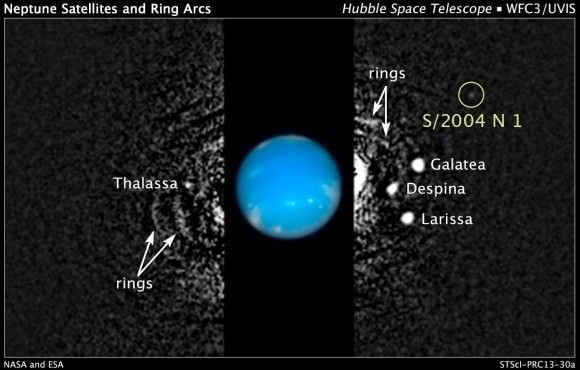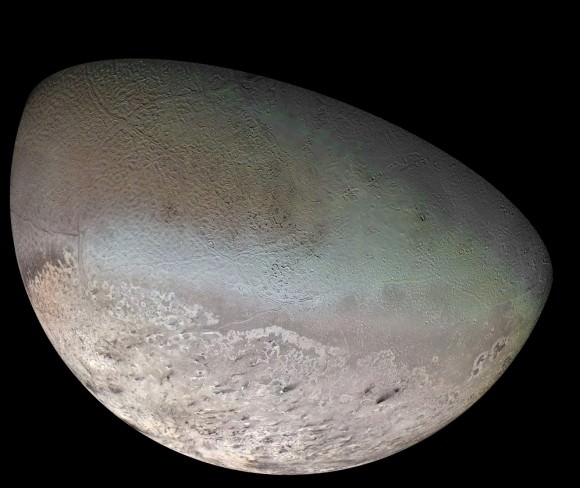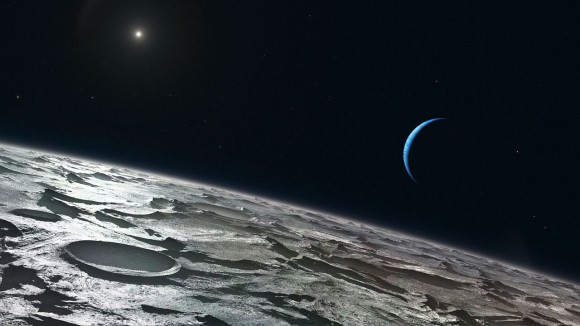Neptune, that icy gas giant that is the eighth planet from our Sun, was discovered in 1846 by two astronomers – Urbain Le Verrier and Johann Galle. In keeping with the convention of planetary nomenclature, Neptune was named after the Roman god of the sea (the equivalent to the Greek Poseidon). And just seventeen days after it was discovered, astronomers began to notice that it too had a system of moons.
Initially, only Triton – Neptune’s largest moon – could be observed. But by the mid-20th century and after, thanks to improvements in ground-based telescopes and the development of robotic space probes, many more moons would be discovered. Neptune now has 14 recognized satellites, and in honor of of their parent planet, all are named for minor water deities in Greek mythology.
Discovery and Naming:
Triton, being the largest and most massive of Neptune’s moons, was the first to be discovered. It was observed by William Lassell on October 10th, 1846, just seventeen days after Neptune was discovered. It would be almost a century before any other moons would be discovered.
The first was Nereid, Neptune’s second largest and most massive moon, which was discovered on May 1st, 1949, by Gerard P. Kuiper (for whom the Kuiper Belt is named) using photographic plates from the McDonald Observatory in Fort Davis, Texas. The third moon, later named Larissa, was first observed by Harold J. Reitsema, William B. Hubbard, Larry A. Lebofsky and David J. Tholen on May 24th, 1981.

The discovery of this moon was purely fortuitous, and occurred as a result of the ongoing search for rings similar to those discovered around Uranus four years earlier. If rings were in fact present, the star’s luminosity would decrease slightly just before the planet’s closest approach. While observing a star’s close approach to Neptune, the star’s luminosity dipped, but only for several seconds. This indicated the presence of a moon rather than a ring.
No further moons were found until Voyager 2 flew by Neptune in 1989. In the course of passing through the system, the space probe rediscovered Larissa and discovered five additional inner moons: Naiad, Thalassa, Despina, Galatea and Proteus.
In 2001, two surveys using large ground-based telescopes – the Cerro Tololo Inter-American Observatory and the Canada-France-Hawaii telescopes – found five additional outer moons bringing the total to thirteen. Follow-up surveys by two teams in 2002 and 2003 respectively re-observed all five of these moons – which were Halimede, Sao, Psamathe, Laomedeia, and Neso.
And then on July 15th, 2013, a team of astronomers led by Mark R. Showalter of the SETI Institute revealed that they had discovered a previously unknown fourteenth moon in images taken by the Hubble Space Telescope from 2004–2009. The as yet unnamed fourteenth moon, currently identified as S/2004 N 1, is thought to measure no more than 16–20 km in diameter.
In keeping with astronomical convention, Neptune’s moons are all taken from Greek and Roman mythology. In this case, all are named for gods of the sea, or for the children of Poseidon (which include Triton, Proteus, Depsina and Thalassa), minor Greek water dieties (Naiad and Nereid) or Nereids , the water nymphs in Greek mythology (Halimede, Galatea, Neso, Sao, Laomedeia and Psamathe).
However, many of the moons were not officially named until the 20th century. The name Triton, which was originally suggested by Camille Flammarion in his 1880 book Astronomie Populaire, but not into common usage until at least the 1930s.
Inner (Regular) Moons:
Neptune’s Regular Moons are those located closest to the planet and which follow circular prograde orbits that lie in the planet’s equatorial plane. They are, in order of distance from Neptune: Naiad (48,227 km), Thalassa (50,074 km), Despina (52,526 km), Galatea (61,953 km), Larissa (73,548 km), S/2004 N 1 (105,300 ± 50 km), and Proteus (117,646 km). All but the outer two are within Neptune-synchronous orbit (meaning that orbit Neptune slower than it’s orbital period (0.6713 days) and thus are being tidally decelerated.
The inner moons are closely associated with Neptune’s narrow ring system. The two innermost satellites, Naiad and Thalassa, orbit between the Galle and LeVerrier rings, whereas Despina orbits just inside the LeVerrier ring. The next moon, Galatea, orbits just inside the most prominent Adams ring and its gravity helps maintaining the ring by containing its particles.
Based on observational data and assumed densities, Naiad measures 96 × 60 × 52 km and weighs approximately 1.9 x 1017 kg. Meanwhile, Thalassa measures 108 x 100 × 52 km and weighs 3.5 x 1017 kg; Despina measures 180 x 148 x 128 and weighs 21 x 1017 kg; Galatea measures 204 x 184 x 144 and weighs 37.5 x 1017 kg; Larissa measures 216 x 204 x 168 and weighs 49.5 x 1017 kg; S/2004 N1 measures 16-20 km in diameter and weighs 0.5 ± 0.4 x 1017 kg; and Proteus measures 436 x 416 x 402 and weighs 50.35 x 1017 kg.
Only the two largest regular moons have been imaged with a resolution sufficient to discern their shapes and surface features. Nevertheless, with the exception of Larissa and Proteus (which are largely rounded) all of Neptune’s inner moons are believed to be elongated in shape. In addition, all the inner moons dark objects, with geometric albedo ranging from 7 to 10%.
Their spectra also indicated that they are made from water ice contaminated by some very dark material, probably organic compounds. In this respect, the inner Neptunian moons are similar to the inner moons of Uranus.
Outer (Irregular) Moons:
Neptune’s irregular moons consist of the planet’s remaining satellites (including Triton). They generally follow inclined eccentric and often retrograde orbits far from Neptune; the only exception is Triton, which orbits close to the planet following a circular orbit, though retrograde and inclined.
In order of their distance from the planet, the irregular moons are Triton, Nereid, Halimede, Sao, Laomedeia, Neso and Psamathe, a group that includes both prograde and retrograde objects. With the exception of Triton and Nereid, Neptune’s irregular moons are similar to those of other giant planets and are believed to have been gravitationally captured by Neptune.
In terms of size and mass, the irregular moons are relatively consistent, ranging from approximately 40 km in diameter and 4 x 1016 kg in mass (Psamathe) to 62 km and 16 x 1016 kg for Halimede.
Triton and Nereid:
Triton and Nereid are unusual irregular satellites and are thus treated separately from the other five irregular Neptunian moons. Between these two and the other irregular moons, four major differences have been noted.
First of all, they are the largest two known irregular moons in the Solar System. Triton itself is almost an order of magnitude larger than all other known irregular moons and comprises more than 99.5% of all the mass known to orbit Neptune (including the planet’s rings and thirteen other known moons).

Secondly, they both have atypically small semi-major axes, with Triton’s being over an order of magnitude smaller than those of all other known irregular moons. Thirdly, they both have unusual orbital eccentricities: Nereid has one of the most eccentric orbits of any known irregular satellite, and Triton’s orbit is a nearly perfect circle. Finally, Nereid also has the lowest inclination of any known irregular satellite
With a mean diameter of around 2700 km and a mass of 214080 ± 520 x 1017 kg, Triton is the largest of Neptune’s moons, and the only one large enough to achieve hydrostatic equilibrium (i.e. is spherical in shape). At a distance of 354,759 km from Neptune, it also sits between the planet’s inner and outer moons.
Triton follows a retrograde and quasi-circular orbit, and is composed largely of nitrogen, methane, carbon dioxide and water ices. With a geometric albedo of more than 70% and a Bond albedo as high as 90%, it is also one of the brightest objects in the Solar System. The surface has a reddish tint, owning to the interaction of ultraviolet radiation and methane, causing tholins.
Triton is also one of the coldest moons in the Solar System, with surface temperature of about 38 K (?235.2 °C). However, owing to the moon being geologically active (which results in cryovolcanism) and surface temperature variations that cause sublimation, Triton is one of only two moons in the Solar System that has a substantial atmosphere. Much like it’s surface, this atmosphere is composed primarily of nitrogen with small amounts of methane and carbon monoxide, and with an estimated pressure of about 14 ?bar.

Triton has a relatively high density of about 2 g/cm3 indicating that rocks constitute about two thirds of its mass, and ices (mainly water ice) the remaining one third. There also may be a layer of liquid water deep inside Triton, forming a subterranean ocean. Surface features include the large southern polar cap, older cratered planes cross-cut by graben and scarps, as well as youthful features caused by endogenic resurfacing.
Because of its retrograde orbit and relative proximity to Neptune (closer than the Moon is to Earth), Triton is grouped with the planet’s irregular moons (see below). In addition, it is believed to be a captured object, possibly a dwarf planet that was once part of the Kuiper Belt. At the same time, these orbital characteristics are the reason why Triton experiences tidal deceleration. and will eventually spiral inward and collide with the planet in about 3.6 billion years.
Nereid is the third-largest moon of Neptune. It has a prograde but very eccentric orbit and is believed to be a former regular satellite that was scattered to its current orbit through gravitational interactions during Triton’s capture. Water ice has been spectroscopically detected on its surface. Nereid shows large, irregular variations in its visible magnitude, which are probably caused by forced precession or chaotic rotation combined with an elongated shape and bright or dark spots on the surface.
Formation:
Given the lopsided distribution of mass in its moons, it is widely believed that Triton was captured after the formation of Neptune’s original satellite system – much of which would have been destroyed in the process of capture. Many theories have been offered regarding the mechanisms of its capture over the years.
The most widely-accepted is that Triton is a surviving member of a binary Kuiper Belt Object that was disrupted with an encounter with Neptune. In this scenario, Triton’s captured was the result of a three-body encounter, where it fell into a retrograde orbit while the other object was either destroyed or ejected in the process.
Triton’s orbit upon capture would have been highly eccentric, and would have caused chaotic perturbations in the orbits of the original inner Neptunian satellites, causing them to collide and reduce to a disc of rubble. Only after Triton’s orbit became circular again could some of the rubble re-accrete into the present-day regular moons. This means it is likely that Neptune’s present inner satellites are not the original bodies that formed with Neptune.
Numerical simulations show that there is a 0.41 probability that the moon Halimede collided with Nereid at some time in the past. Although it is not known whether any collision has taken place, both moons appear to have similar (“grey”) colors, implying that Halimede could be a fragment of Nereid.
Given its distance from the Sun, the only mission to ever study Neptune and its moons up close was the Voyager 2 mission. And though no missions are currently being planned, several proposals have been made that would see a robotic probe dispatched to the system sometime in the late 2020s or early 2030s.
We have many interesting articles on Neptune, Neptune’s Moons, and the Trans-Neptunian region here at Universe Today. Here’s a full article about Neptune’s Moon Triton, Naiad and Nereid and S/2004 N 1.
Here’s a lovely article on the latest Trans-Neptunian Objects to be discovered, and how Astronomer are Predicting at Least Two More Large Planets in the Solar System
For more information, check out NASA’s Solar System Exploration page titled “Neptune: The Windiest Planet”.

